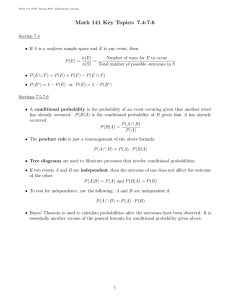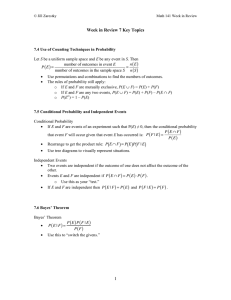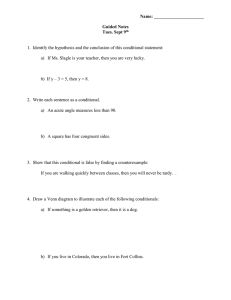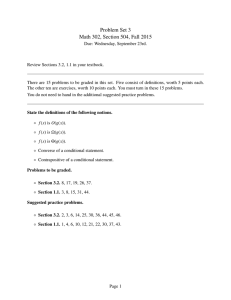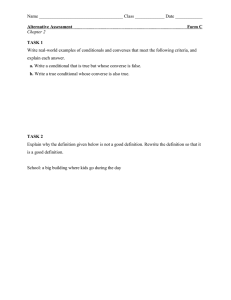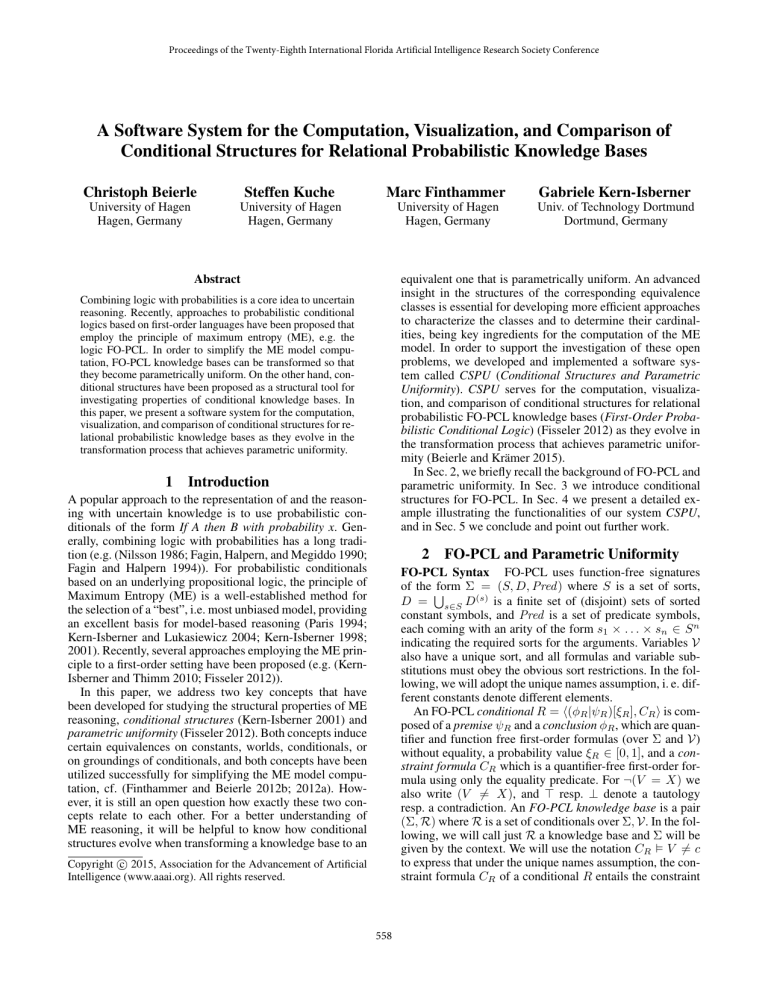
Proceedings of the Twenty-Eighth International Florida Artificial Intelligence Research Society Conference
A Software System for the Computation, Visualization, and Comparison of
Conditional Structures for Relational Probabilistic Knowledge Bases
Christoph Beierle
Steffen Kuche
Marc Finthammer
Gabriele Kern-Isberner
University of Hagen
Hagen, Germany
University of Hagen
Hagen, Germany
University of Hagen
Hagen, Germany
Univ. of Technology Dortmund
Dortmund, Germany
Abstract
equivalent one that is parametrically uniform. An advanced
insight in the structures of the corresponding equivalence
classes is essential for developing more efficient approaches
to characterize the classes and to determine their cardinalities, being key ingredients for the computation of the ME
model. In order to support the investigation of these open
problems, we developed and implemented a software system called CSPU (Conditional Structures and Parametric
Uniformity). CSPU serves for the computation, visualization, and comparison of conditional structures for relational
probabilistic FO-PCL knowledge bases (First-Order Probabilistic Conditional Logic) (Fisseler 2012) as they evolve in
the transformation process that achieves parametric uniformity (Beierle and Krämer 2015).
In Sec. 2, we briefly recall the background of FO-PCL and
parametric uniformity. In Sec. 3 we introduce conditional
structures for FO-PCL. In Sec. 4 we present a detailed example illustrating the functionalities of our system CSPU,
and in Sec. 5 we conclude and point out further work.
Combining logic with probabilities is a core idea to uncertain
reasoning. Recently, approaches to probabilistic conditional
logics based on first-order languages have been proposed that
employ the principle of maximum entropy (ME), e.g. the
logic FO-PCL. In order to simplify the ME model computation, FO-PCL knowledge bases can be transformed so that
they become parametrically uniform. On the other hand, conditional structures have been proposed as a structural tool for
investigating properties of conditional knowledge bases. In
this paper, we present a software system for the computation,
visualization, and comparison of conditional structures for relational probabilistic knowledge bases as they evolve in the
transformation process that achieves parametric uniformity.
1
Introduction
A popular approach to the representation of and the reasoning with uncertain knowledge is to use probabilistic conditionals of the form If A then B with probability x. Generally, combining logic with probabilities has a long tradition (e.g. (Nilsson 1986; Fagin, Halpern, and Megiddo 1990;
Fagin and Halpern 1994)). For probabilistic conditionals
based on an underlying propositional logic, the principle of
Maximum Entropy (ME) is a well-established method for
the selection of a “best”, i.e. most unbiased model, providing
an excellent basis for model-based reasoning (Paris 1994;
Kern-Isberner and Lukasiewicz 2004; Kern-Isberner 1998;
2001). Recently, several approaches employing the ME principle to a first-order setting have been proposed (e.g. (KernIsberner and Thimm 2010; Fisseler 2012)).
In this paper, we address two key concepts that have
been developed for studying the structural properties of ME
reasoning, conditional structures (Kern-Isberner 2001) and
parametric uniformity (Fisseler 2012). Both concepts induce
certain equivalences on constants, worlds, conditionals, or
on groundings of conditionals, and both concepts have been
utilized successfully for simplifying the ME model computation, cf. (Finthammer and Beierle 2012b; 2012a). However, it is still an open question how exactly these two concepts relate to each other. For a better understanding of
ME reasoning, it will be helpful to know how conditional
structures evolve when transforming a knowledge base to an
2
FO-PCL and Parametric Uniformity
FO-PCL Syntax FO-PCL uses function-free signatures
of the S
form Σ = (S, D, Pred ) where S is a set of sorts,
D = s∈S D(s) is a finite set of (disjoint) sets of sorted
constant symbols, and Pred is a set of predicate symbols,
each coming with an arity of the form s1 × . . . × sn ∈ S n
indicating the required sorts for the arguments. Variables V
also have a unique sort, and all formulas and variable substitutions must obey the obvious sort restrictions. In the following, we will adopt the unique names assumption, i. e. different constants denote different elements.
An FO-PCL conditional R = h(φR |ψR )[ξR ], CR i is composed of a premise ψR and a conclusion φR , which are quantifier and function free first-order formulas (over Σ and V)
without equality, a probability value ξR ∈ [0, 1], and a constraint formula CR which is a quantifier-free first-order formula using only the equality predicate. For ¬(V = X) we
also write (V 6= X), and > resp. ⊥ denote a tautology
resp. a contradiction. An FO-PCL knowledge base is a pair
(Σ, R) where R is a set of conditionals over Σ, V. In the following, we will call just R a knowledge base and Σ will be
given by the context. We will use the notation CR V 6= c
to express that under the unique names assumption, the constraint formula CR of a conditional R entails the constraint
Copyright c 2015, Association for the Advancement of Artificial
Intelligence (www.aaai.org). All rights reserved.
558
V 6= c, and CR 2 V 6= c means that CR does not entail the
constraint.
The constraint formula makes it possible to explicitly express that a generic conditional is not applicable with respect
to a particular individual. Without constraint formulas, having a generic conditional and a corresponding conditional
for a specific individual, that specific conditional might formally contradict the general one when considering all instances.
Example 1 (Misanthrope). The knowledge base R =
{R1 , R2 }, adapted from (Fisseler 2012), models friendship
relations within a group of people, with one exceptional
member, a misanthrope. In general, if a person V likes another person U, then it is very likely that U likes V, too. But
there is one person, the misanthrope, who generally does not
like other people:
R1 : h(likes(U, V )|likes(V, U ))[0.9], U 6= V i
R2 : h(likes(a, V ))[0.05], V 6= ai
Please note that given the set of contants D = {a, b, c},
instantiating the conditionals in R without considering their
constraint formulas would yield the contradictory conditional h(likes(a, a)|likes(a, a))[0.9].
When the constraint formula of a ground instance of R
evaluates to true, that instance is called admissible, and
gnd (R) denotes the set of all admissible instances of R (over
Σ), in the following also just called instances.
p∗X(R) (x) =
(θ
(φ
)∧θ
(ψ
X
λgRk fgRk (x) (2)
k=1 gRk ∈gnd(Rk )
where fgRk is the feature function determined by gRk , λgRk
is a Lagrange multiplier (Boyd and Vandenberghe 2004) and
Z is a normalization constant. We will not elaborate on the
details of Equation (2) as they are not important for the rest
of this work (see (Fisseler 2012) for a detailed explanation).
What is important to note is that according to Equation (2),
one optimization parameter λgRk has to be determined for
each single ground instance gRk of each conditional Rk .
This readily yields a computationally infeasible optimization problem for larger knowledge bases because there might
be just too many ground instances.
However, there are FO-PCL knowledge bases for which
the ground instances of a conditional share the same
entropy-optimal parameter. Parametric uniformity (Fisseler
2012) means that for each conditional all its ground instances share the same entropy-optimal parameter value.
The advantage of the semantical notion of parametric uniformity is that just one optimization parameter λRk per conditional Rk has to be computed instead of one parameter per
ground instance :
m
X
X
1
p∗X(R) (x) = exp
λ Rk
fgRk (x) (3)
Z
FO-PCL Models The Herbrand base H(R) is the set of
all atoms in all gnd (Rk ) with Rk ∈ R, and every subset
x ⊆ H(R) is a Herbrand interpretation, also called world,
defining a logical semantics for R. The set X(R) = {x |
x ⊆ H(R)} denotes the set of all Herbrand interpretations.
The probabilistic semantics of R is a possible world semantics (Halpern 2005) where the ground atoms in H(R) are
binary random variables. An FO-PCL interpretation pX(R)
of R is thus a probability distribution over X(R).
For Rk ∈ R and every gRk ∈ gnd (Rk ), let θRk be an
admissible ground substitution for the variables in Rk so that
gRk = h(θgRk (φRk ) | θgRk (ψRk ))[ξRk ], >i. Then pX(R)
satisfies Rk iff for every instance gRk ∈ gnd (Rk ) we have:
pX(R) (θRk (φRk ) ∧ θRk (ψRk )) = ξRk · pX(R) (θRk (ψRk )).
Note that for the case of pX(R) (θRk (ψRk )) > 0, this equap
1
exp
Z
m
X
k=1
gRk ∈gnd(Rk )
Parametric uniformity indicates identical knowledge
about all ground instances of the same conditional for an
FO-PCL knowledge base R. Due to this, one should be able
0
of a conditional
to transpose two ground instances gRk , gR
k
in R without changing the joint probability function with
maximum entropy. In this case the transposed ground instances must possess the same entropy optimal parameter,
as the Gibbs distribution in Equation (2) is determined by a
unique set of Lagrange multipliers (Fisseler 2012).
In the following, the ME model of an FO-PCL knowledge
∗
.
base R will be denoted by PR
Interactions and Transformation Rules Luckily, each
FO-PCL knowledge base R that is not parametrically uniform can be transformed into an equivalent R’ that is parametrically uniform. This is achieved by the set of transformations rules PU developed in (Beierle and Krämer 2015).
In (Beierle and Krämer 2015), the reasons causing R to be
not parametrically uniform are investigated in detail and the
syntactic criterion of inter-rule and intra-rule interactions is
introduced. For each of the different types of interactions,
there is a corresponding interaction removing transformation rule in PU (Beierle and Krämer 2015), for instance:
))
Rk
Rk
Rk
Rk
tion is equivalent to X(R)pX(R)
= ξRk and
(θRk (ψRk ))
thus to pX(R) ((θgRk (φRk ) | θgRk (ψRk ))) = ξRk , expressing conditional probability. pX(R) is a model of R, denoted
by pX(R) |= R, if it satisfies every Rk ∈ R.
Maximum Entropy Model and Parametric Uniformity
A knowledge base R = {R1 , . . . , Rm } may have many different models, and the principle of maximum entropy (Paris
1994; Kern-Isberner and Lukasiewicz 2004; Kern-Isberner
1998; 2001) provides a method to select a model that is
optimal in the sense that it is the most unbiased one. The
uniquely determined model
p∗X(R) = arg max H(pX(R) )
(1)
(TE 1 )
pX(R) |=R
R ∪ {R1 , R2 }
R1 ← hP iV,c → R2 ,
R ∪ {R1 } ∪ ν{σ(R2 ), σ(R2 )} σ = {V /c}
Example 2 (Application of PU). Among the conditionals
R1 and R2 from Example 1 there is an inter-rule interaction
of type 1, denoted by R2 ← hlikesiV,a → R1 . The transfor-
of R having maximum entropy H(p∗X(R) ) can be represented by a Gibbs distribution (Geman and Geman 1984):
559
mation rule (TE 1 ) removes it by replacing R1 with
R1 1 : h(likes(U, a) | likes(a, U )) [0.9] , U 6= ai
R1 2 : h(likes(U, V ) | likes(V, U )) [0.9] , U 6= V ∧ V 6= ai.
Thus, the transformation rule (TE 1 ) removes an interrule interaction of type 1 by replacing a conditional R with
two new conditionals ν(σ(R)) and ν(σ̄(R)), where σ(R) is
the result of applying the variable substitution σ = {V /c}
to R, and σ̄(R) is the result of adding the constraint V 6= c
to the constraint formula of R. The operator ν transforms a
conditional in constraint normal form. Similarly, there are
two transformation rules (TE 2 ) and (TE 3 ) that remove
inter-rule interactions of type 2 and 3. The three different
types of intra-rule interactions occur within a single conditional and are removed by one of the three rules (TA1 ),
(TA2 ), (TA3 ) in PU (Beierle and Krämer 2015).
Proposition 1. (Beierle and Krämer 2015) Applying PU
to a knowledge base R terminates and yields a knowledge
base PU(R) having the same maximum-entropy model and
PU(R) is parametrically uniform.
We refer to (Beierle and Krämer 2015) for further details
of PU, including many examples, formal definitions and
proofs.
3
Definition 2 (vf-Pair, FO-PCL Conditional Structure).
For a world ω, the pair (ver i (ω), fal i (ω)) ∈ N0 × N0 is
called the vf-pair of ω with respect to conditional Ri . The
conditional structure γR (ω) of ω with respect to an FO-PCL
knowledge base R = {R1 . . . , Rm } is the m-tuple:
γR (ω) := ( (ver 1 (ω), fal 1 (ω)) , . . . ,
(4)
(ver m (ω), fal m (ω)) ) ∈ (N0 × N0 )
m
Example 3. For R from Example 1 with D = {a, b, c}, the
world ω = {likes(a, b), likes(b, a)} e.g. falsifies the grounding h(likes(a, c))[0.05], >i of R2 . Its conditional structure is
γR (ω) = ((2, 0), (1, 1)).
Note that the conditional structure γR (ω) does not take
any probabilities into account, i.e., it just considers the logical part of the conditionals in R. This logical structure induces an equivalence relation on worlds.
Definition 3 (Structural Equivalence). Two worlds
ω1 , ω2 ∈ Ω are structurally equivalent with respect to R, denoted by ω1 ≡R ω2 , iff γR (ω1 ) = γR (ω2 ). With [ωl ]≡R :=
{ω ∈ Ω | ω ≡R ωl } we denote the equivalence class of
ωl ∈ Ω, with Ω/ ≡R := {[ω]≡R | ω ∈ Ω} the set of all
equivalence classes, and with |[ωl ]≡R | the cardinality of the
equivalence class [ωl ]≡R .
∗
An important observation is that the ME distribution PR
of R respects the conditional structure for parametrically
uniform R: While in general, a probability distribution satisfying R may assign different probabilities to worlds having
the same conditional structure, such worlds always have the
∗
same probability under PR
.
FO-PCL and Conditional Structures
Kern-Isberner (2001) investigates the behaviour of worlds
with respect to conditionals and introduces the concept of
conditional structure of a world with respect to a set of
propositional conditionals Rpr . Formally, the conditional
structure of ω with respect to Rpr is given by a product
in a free abelian group with generators indicating that ω
verifies resp. falsifies the i-th conditional in Rpr . KernIsberner’s idea of a conditional structure carries over to the
relational case by employing functions counting the number
of verifying and falsifying groundings (Kern-Isberner and
Thimm 2012). Since each free abelian group is isomorphic
to a cartesian product of copies of the set of integers Z, the
extension of a conditional structure of a world to the relational setting can also be defined by using ordered tuples
instead of a free abelian group notation (Finthammer and
Beierle 2012b). Both in (Kern-Isberner and Thimm 2012)
and (Finthammer and Beierle 2012b), conditional structures
are defined for relational conditionals under aggregation semantics (Kern-Isberner and Thimm 2010). In the following,
we will adapt this notion to the FO-PCL case by taking the
constraint formulas of FO-PCL conditionals into account,
and as in (Finthammer and Beierle 2012b), we will use ordered tuples for representing conditonal structures.
Definition 1 (FO-PCL Counting Functions). For an FOPCL conditional Ri = h(φR |ψR )[ξR ], CR i the counting
functions ver i , fal i : Ω → N0 are given by:
Proposition 2. If R is parametrically uniform, then for
∗
∗
ω1 , ω2 ∈ Ω, ω1 ≡R ω2 implies PR
(ω1 ) = PR
(ω2 ).
For proving Proposition 2, the feature functions for a conditional R used in Equations (2) and (3) are expressed in
terms of the FO-PCL counting functions for R and the probability of R, similar as it is done in (Finthammer and Beierle
2012b) for aggregation semantics.
The observations outlined above strongly indicate that
both conditional structures and parametric uniformity are
crucial concepts for describing properties of FO-PCL knowledge bases with ME semantics. Moreover, both concepts
can be exploited successfully in ME model computations
(e.g. (Finthammer and Beierle 2012b; 2012a)). Still, up to
now the exact relationship between the two concepts is not
known, e.g., to which extent can both notions be expressed
in terms of the other one? How do conditional structures
evolve along the transformation steps when applying PU?
How do the induced equivalence classes of worlds change
accordingly? For supporting the study of these questions
we designed and implemented a system for the computation
and comparison of conditional structures in connection with
the PU transformation process. This system is part of the
KR EATOR environment1 (Finthammer and Thimm 2012),
an integrated development environment for relational probabilistic logic; its functionality is illustrated in the following
section.
ver i (ω) = |{h(φg |ψg )[ξ], >i ∈ gnd (Ri ) | ω |= ψg ∧ φg }|
fal i (ω) = |{h(φg |ψg )[ξ], >i ∈ gnd (Ri ) | ω |= ψg ∧ ¬φg }|
ver i (ω) indicates the number of groundings of Ri which
are verified by ω, whereas fal i (ω) specifies the number of
groundings of Ri which are falsified by ω.
Considering the counting functions of all conditionals in
a knowledge base R yields the conditional structure of R.
1
560
KR EATOR can be found at http://kreator-ide.sourceforge.net/
Figure 1: Navigation for PU transformation report
4
System Illustration and Examples
The KR EATOR extension CSPU performs the PU transformation process and calculates the conditional structures of
all knowledge bases arising from it. The complete information of the PU transformation process of a knowledge
base is summarized in a PU transformation process report
or simply PU report. One part of this PU report is a table
wherein each knowledge base is represented as a column
and each world is represented as a row, with the number
of worlds typically being very large. Furthermore, a graph
representing the relations among the equivalence classes of
worlds may contain thousands of nodes and edges, which is
also not representable in a static textual representation format. Therefore, HTML was chosen as the format of the report. With the help of HTML it is possible to manage large
tables and graphs by providing appropriate navigation and
visualization tools. Of course, the size of an HTML table is
also limited. Therefore, if a knowledge base has more than
10000 worlds, the table is split into multiple files, where
each file contains at most 10000 worlds. Moreover, the dynamic nature of HTML is utilized, e.g., to fade in additional
information on demand, or to provide a paging mechanism
on the rows of the table. In the following, we will illustrate
the PU report for the knowledge base R from Example 1.
The first part of the report consists of the knowledge base
and its Herbrand base, along with a navigation panel (Figure 1). Subsequently, the individual steps of the PU transformation process are shown, with the following information
being displayed for each transformation step (cf. Figure 2):
The substituted conditional, the two newly added conditionals, the resulting knowledge base, the interaction type being
resolved by the transformation step, and a brief explanation
of the interaction. Another part of the report is a table representing all knowledge bases arising from the transformation
process and the corresponding conditional structures for all
worlds (Figure 3). For each world, its probability under the
∗
ME model PR
is given. Detailed information is available on
demand, e.g., a listing of all groundings of a conditional being verified or falsified by a particular world (Figure 4).
The induced equivalence classes of each knowledge base
arising from the transformation process are represented in
separate tables. Each row represents one equivalence class
Figure 2: PU transformation steps from R = R1 to R2 and
from R2 to R3 = PU(R) for R from Example 1
and includes the conditional structure, its worlds, and the
number of different probabilities of its worlds. It is possible
to fade in the occurring probabilities and the ground atoms
Figure 4: Explanation of the conditional of structure of the
knowledge base R = {R1 , R2 } w.r.t. a specific world
561
Figure 3: Comparison of conditional structures induced by PU transformation process
Figure 6: Visualization of relations among equivalence classes of worlds induced by a PU transformation process
lence classes.
Since in each PU transformation step one conditional is
replaced by two conditionals, one vf-pair of each conditional
structure of a knowledge base is partitioned into two vf-pairs
by each transformation step (Figure 7).
Example 4. The first PU transformation step for R from
Example 1 replaces R1 by two conditionals (cf. Example 2).
The conditional structure of ω = {likes(a, b), likes(b, a)} is
transformed correspondingly from ((2, 0), (1, 1) for R (cf.
Example 3) to ((1, 0), (1, 0), (1, 1)) for the knowledge base
resulting from the first PU transformation step.
The other two possible partitionings of the vf-pair (2, 0)
are ((0, 0), (2, 0)) and ((2, 0), (0, 0)), where the latter does
not occur. This information is also given, together with the
information how many (and which) worlds share the same
vf-pairs, both before and after the transformation step.
Figure 5: Visualization of equivalence classes of worlds
of each world in one equivalence class (Figure 5). E.g., the
class EC1−2 (w.r.t. R1 ) contains the worlds 4,5,6,7 showing
two different probabilities. Figure 3 reveals that these worlds
have the same conditional structure w.r.t. both R1 and R2 .
However, as implied by Proposition 2, the conditional structure w.r.t. R3 accurately distinguishes the worlds 4, 6 and 5,
7, respectively, since R3 is parametrically uniform.
The relations of equivalence classes among each other
are visualized by a graph (Figure 6), with the classes in
the i-th row corresponding to the knowledge base before
the i-th transformation step. For instance, both the classes
EC1−2 induced by R1 and EC2−2 induced by R2 contain
the worlds 4, 5, 6, 7. EC2−2 is then split up into EC3−2
with worlds 5, 7 and EC3−4 with worlds 4, 6. It is possible
to navigate directly to an equivalence class by clicking on
the label of a node. An edge is labeled with the indices of
the first five common worlds of the corresponding equiva-
5
Conclusions and Further Work
In order to support a better understanding of conditional
structures and of parametric uniformity – two key concepts
for ME model computation and reasoning for relational
probabilistic knowledge bases – we presented the software
system CSPU computing, visualizing, and analyzing them.
CSPU has already been a valuable tool in experimenting
with different knowledge bases and evaluating them with
respect to several important parameters. These directly address the questions raised at the end of Section 3 and include the number of equivalence classes and of vf-pairs, the
partitioning of vf-pairs, and the comparison of first-order
conditionals and their instances under maximum entropy
562
Fagin, R.; Halpern, J. Y.; and Megiddo, N. 1990. A logic for
reasoning about probabilities. Information and Computation
87(1-2):78 – 128.
Finthammer, M., and Beierle, C. 2012a. How to exploit
parametric uniformity for maximum entropy reasoning in a
relational probabilistic logic. In JELIA 2012, volume 7519
of LNAI, 189–201. Springer.
Finthammer, M., and Beierle, C. 2012b. Using equivalences
of worlds for aggregation semantics of relational conditionals. In KI 2012, LNAI 7526, 49–60. Springer.
Finthammer, M., and Thimm, M. 2012. An integrated development environment for probabilistic relational reasoning.
Logic Journal of the IGPL 20(5):831–871.
Fisseler, J. 2012. First-order probabilistic conditional
logic and maximum entropy. Logic Journal of the IGPL
20(5):796–830.
Geman, S., and Geman, D. 1984. Stochastic relaxation,
gibbs distributions, and the bayesian restoration of images.
IEEE Transactions on Pattern Analysis and Machine Intelligence 6:721–741.
Halpern, J. 2005. Reasoning About Uncertainty. MIT Press.
Kern-Isberner, G., and Lukasiewicz, T. 2004. Combining
probabilistic logic programming with the power of maximum entropy. Artif. Intell. 157(1-2):139–202.
Kern-Isberner, G., and Thimm, M. 2010. Novel semantical
approaches to relational probabilistic conditionals. In Proc.
KR-2010, 382–391. Menlo Park, CA: AAAI Press.
Kern-Isberner, G., and Thimm, M. 2012. A ranking semantics for first-order conditionals. In ECAI-2012, 456–461.
IOS Press.
Kern-Isberner, G. 1998. Characterizing the principle of minimum cross-entropy within a conditional-logical framework.
Artificial Intelligence 98:169–208.
Kern-Isberner, G. 2001. Conditionals in nonmonotonic reasoning and belief revision. Springer, Lecture Notes in Artificial Intelligence LNAI 2087.
Nilsson, N. 1986. Probabilistic logic. Artificial Intelligence
28:71–87.
Paris, J. 1994. The uncertain reasoner’s companion – A
mathematical perspective. Cambridge University Press.
Poole, D. 2003. First-order probabilistic inference. In Gottlob, G., and Walsh, T., eds., Proc. IJCAI-03, 985–991. Morgan Kaufmann.
Figure 7: Partitionings of vf-pairs induced by PU
semantics (Beierle, Finthammer, and Kern-Isberner 2015).
Our future work also includes the investigation of the exact
relationship of techniques of lifted inference (Poole 2003;
de Salvo Braz, Amir, and Roth 2005) to the concepts presented in this paper.
References
Beierle, C., and Krämer, A. 2015. Achieving parametric
uniformity for knowledge bases in a relational probabilistic
conditional logic with maximum entropy semantics. Annals
of Mathematics and Artificial Intelligence 73(1-2):5–45.
Beierle, C.; Finthammer, M.; and Kern-Isberner, G. 2015.
Relational probabilistic conditionals and their instantiations
under maximum entropy semantics for first-order knowledge bases. Entropy 17(2):852–865.
Boyd, S., and Vandenberghe, L. 2004. Convex Optimization.
New York, NY, USA: Cambridge University Press.
de Salvo Braz, R.; Amir, E.; and Roth, D. 2005. Lifted
first-order probabilistic inference. In IJCAI-05, 1319–1325.
Professional Book Center.
Fagin, R., and Halpern, J. Y. 1994. Reasoning about knowledge and probability. J. ACM 41(2):340–367.
563

